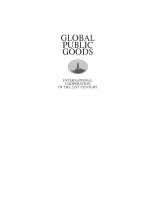Psychology applied to modern life adjustment in the 21st century, 11e chapter 9
Bạn đang xem bản rút gọn của tài liệu. Xem và tải ngay bản đầy đủ của tài liệu tại đây (1.34 MB, 60 trang )
Chapter 9
Friendship and Love
Perspectives on Close Relationships
•
The Ingredients of close relationships
– Close relationships – “are those that are
important, interdependent, and long lasting”.
– They come in many forms, including
• Family relationships.
• Friendships.
• Work relationships.
• Romantic relationships.
• Marriage.
Perspectives, continued
• Close relationships arouse intense feelings that
are both
– Positive (passion, concern, caring) and
– Negative (rage, jealousy, despair).
• This is referred to as the paradox of close
relationships.
Attraction and Development, continued
•
Initial encounters
– Three factors underlie initial attraction
between strangers:
1. Proximity – we are more likely to become
involved with people we are geographically,
or spatially, close to.
2. Familiarity – the mere exposure effect
states that positive feelings toward a person
are increased the more often we see them.
Attraction and Development, continued
Initial encounters, continued
3. Physical attractiveness
– This factor plays a key role in face-to-face
romantic relationships as well as
friendships.
– However, cross-cultural research suggests
it is not the most important factor, for both
males and females
– See Figure 9.1 for a summary.
Figure 9.1. Rank order of traits chosen by men and women as one of their most important traits in a
partner. In a 2005 international Internet survey of over 200,000 participants (including heterosexuals and
homosexuals, men and women), Lippa (2007) found that intelligence, humor, honesty, kindness, and good
looks were ranked (in that order) as the most important traits in a partner for all participants. However, when
separated by gender, good looks ranked higher.
Attraction and Development, continued
Initial encounters, continued
• What makes someone attractive?
– Facial features
• For women: “baby-faced” features, (large
eyes, small nose), combined with “mature”
features (prominent cheekbones).
• For men: a strong jaw and broad
forehead.
Attraction and Development, continued
What makes people attractive, continued
– Physique
•
•
For women: average weight, an
“hourglass” figure, and medium-sized
breasts.
For men: broad shoulders and a slim
waist.
Attraction and Development, continued
What makes people attractive, continued
– Expressive traits (large smile, high set
eyebrows) are seen as attractive because
they suggest friendliness.
– Grooming qualities are also desirable,
including cosmetic enhancements (see
Figure 9.2).
Figure 9.2. Top five surgical cosmetic procedures in 2008. The number of cosmetic surgeries
annually is on the rise. In 2008, over 10.2 million cosmetic procedures were performed.
Retrieved December 23, 2009 from the American Society for Aesthetic Plastic Surgery, 2008,
/>
Attraction and Development, continued
What makes people attractive, continued
– Matching up on looks
•
The matching hypothesis – “proposes
that people of similar levels of physical
attractiveness gravitate toward each
other.”
Attraction and Development, continued
What makes people attractive, continued
– Attractiveness and resource exchange
•
In contrast, the resource exchange is an
evolution-based theory proposing that “in
heterosexual dating, males ‘trade’
occupational status for physical
attractiveness in females”.
Attraction and development, continued
Resource Exchange theory, continued
• David Buss (1988) believes mating patterns
depend on what each sex has to invest in terms
of survival.
– For men, reproductive opportunities are the
most important, so they show more interest in
sexual activity and physical attractiveness.
– Parental investment theory (see Figure 9.3)
states women choose mates that will supply
resources needed to support offspring for
many years.
Figure 9.3. Parental investment theory and mating preferences. Parental investment theory suggests
that basic differences between males and females in parental investment have great adaptive significance
and lead to gender differences in mating propensities and preferences, as outlined here.
Attraction and Development, continued
•
Getting acquainted
– Three factors affect viability of relationships:
1. Reciprocal liking – “refers to liking those
who show that they like you”.
2. Similarity – we are drawn to those with
similar qualities.
– This is true in friendships and romantic
relationships, regardless of sexual
orientation.
– Similar attitudes play a key role.
Attraction and Development, continued
Getting acquainted, continued
3. Desirable personality characteristics
– For future spouses or life partners,
personal qualities are more important
than physical traits.
– Most desirable personality traits were
warmth, good sense of humor, and
social assertiveness.
Attraction and Development, continued
•
Established relationships
– Maintenance of ongoing relationships
– Relationship maintenance – involves “the
actions and activities used to sustain the
desired quality of a relationship” (see Figure
9.5).
Figure 9.5. Relationship maintenance strategies. College students were asked to describe how they
maintained three different personal relationships over a college term. Their responses were grouped into 11
categories. You can see that, ironically, some people behave negatively in an attempt to enhance
relationships. Openness was the most commonly nominated strategy. (Adapted from Canary & Stafford,
1994)
Attraction and Development, continued
•
Established relationships, continued
– The process of minding relationships is an
active process that involves
• Using good listening skills.
• Knowing your partner’s opinions.
• Making positive attributions about your
partner’s behavior.
Attraction and Development, continued
Established relationships, continued
– Expressing feelings of trust and commitment.
– Recognizing your partner’s support and
effort.
– Being optimistic about the future of the
relationship.
Attraction and Development, continued
•
Relationship satisfaction and commitment
– What determines whether you will stay in the
relationship or get out?
• Interdependence or social exchange
theory states that the decision is based
on a “cost-benefit” analysis of the
relationship’s outcome. If the rewards
outweigh the costs, we stay.
Attraction and Development, continued
Interdependence theory, continued
• Relationship satisfaction is gauged by our
comparison level – or “personal standard
of what constitutes an acceptable balance
of rewards and costs”.
– It is based on outcomes experienced in
previous relationships and on outcomes
seen in other people’s relationships.
Attraction and Development, continued
Interdependence theory, continued
• Relationship commitment is determined by
two factors:
1. The comparison level for
alternatives, or “one’s estimation of the
available outcomes from alternative
relationships”.
– We tend to stay in unsatisfying
relationships until a better one
comes along.
Attraction and Development, continued
Interdependence theory, continued
2. The investments, or “things that
people contribute to a relationship that
they can’t get back if the relationship
ends”.
– Thus, putting investments into a
relationship strengthens our
commitment to it (see Figure 9.6).
Figure 9.6. The key elements of social exchange theory and their effects on a relationship. According
to social exchange theory, relationship outcome is determined by the rewards minus the costs of a
relationship. Relationship satisfaction is based on the outcome matched against comparison level
(expectations). Commitment to a relationship is determined by one’s satisfaction minus one’s comparison
level for alternatives plus one’s investments in the relationship.
Adapted from Brehm, S.S., & Kassin, S.M. (1993). Social psychology. Boston: Houghton Mifflin.
Copyright © 1993 by Houghton Mifflin Company. Adapted with permission.









